41.4 Configuring Domain Maintenance
You can configure the MTA to synchronize user information in the GroupWise Address Book with user information in eDirectory. You can also configure it to gather information about all messages that pass through the domain for tracking purposes.
41.4.1 Using eDirectory User Synchronization
As long as GroupWise administration is performed with the GroupWise Administrator snap-in to ConsoleOne running, user information is automatically synchronized between GroupWise and eDirectory. However, four situations can cause this automatic synchronization to be insufficient:
-
An administrator modifies user information in ConsoleOne without having the GroupWise Administrator snap-in running.
-
The user information was changed using NetWare® Administrator without the GroupWise Administrator snap-in running.
-
The user information was changed using Novell iManager.
-
The user information was changed using Novell eGuide and the GroupWise Identity Manager driver is not in use
In these situations, user information in eDirectory no longer matches corresponding user information in GroupWise. (User objects are the only GroupWise objects that can be modified without the GroupWise Administrator snap-in running. Modification of all other GroupWise objects requires the presence of the GroupWise Administrator snap-in.)
This section covers the following aspects of eDirectory user synchronization:
Enabling eDirectory User Synchronization
By default, eDirectory user synchronization is disabled. The MTA still performs all its other functions, but any changes made to user information in eDirectory without the GroupWise Administrator snap-in running will not appear in GroupWise until eDirectory user synchronization has been performed.
Although all MTAs can be enabled to perform eDirectory user synchronization, the minimum requirement is that at least one MTA be configured that way. If your GroupWise system spans multiple trees, at least one MTA in each tree must be configured to perform eDirectory user synchronization. The MTA server should have a local eDirectory replica for the MTA to access.
-
In ConsoleOne, click to display the eDirectory User Synchronization Configuration dialog box.
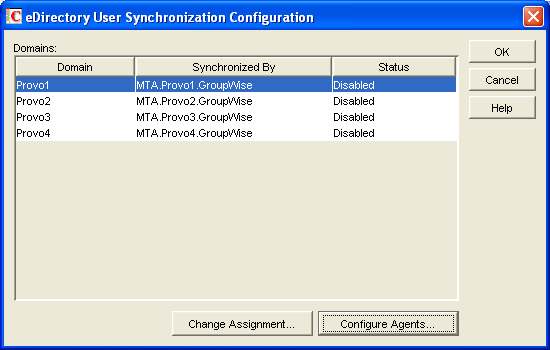
The eDirectory User Synchronization Configuration dialog box lists all domains in your GroupWise system, the MTA currently assigned to provide eDirectory user synchronization for each domain, and the current status of that agent’s ability to perform eDirectory user synchronization.
-
Click
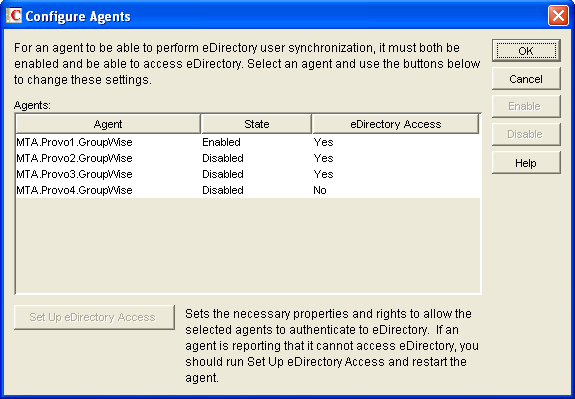
Only domains with NetWare MTAs or Linux MTAs should be listed, because eDirectory user synchronization is not supported by the Windows MTA.
If domains on Windows servers are listed:
-
Cancel out of the eDirectory user synchronization dialog boxes.
-
Browse to and right-click a misconfigured MTA, then click .
-
In the field, select the platform where the MTA is running.
-
Click to save the correct platform information.
-
Return to .
-
-
Select the NetWare MTA that you want to perform eDirectory user synchronization.
-
If the column for that NetWare displays , click .
or
If the column for that NetWare MTA displays :
-
Click .
-
Browse to and select the NetWare server where the MTA runs.
-
Click .
The column for that NetWare MTA should now display so that you can enable it.
-
-
Select a Linux MTA that you want to perform eDirectory user synchronization.
-
If the column for that Linux MTA displays , click .
or
If the column for that Linux MTA displays No:
-
Click .
-
In the list, select the LDAP server that you want the MTA to log into in order to gain access to eDirectory, then click .
-
In thefield, browse to and select the user that the MTA can use to log in as.
The selected user must have rights to browse properties of User objects.
Click , provide the password associated with the user selected above, then click .
-
Click to save the LDAP information.
The column for that Linux MTA should now display so that you can enable it.
-
-
If your GroupWise system spans multiple trees, repeat Step 3 through Step 6 as needed to enable eDirectory user synchronization for at least one MTA in each tree.
-
Click to return to the eDirectory User Synchronization Configuration dialog box.
Each domain for which you have configured the MTA for eDirectory user synchronization should now display Enabled in the Status column.
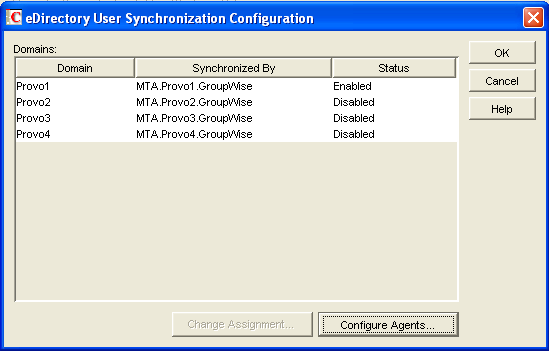
-
If all domains are now enabled, click to return to main ConsoleOne window, then continue with Scheduling eDirectory User Synchronization.
or
If some domains are still disabled, continue with Assigning an eDirectory-Enabled MTA to Synchronize Other Domains.
Assigning an eDirectory-Enabled MTA to Synchronize Other Domains
After at least one MTA is performing eDirectory user synchronization, other MTAs not performing eDirectory user synchronization themselves can have an eDirectory-enabled MTA gather the eDirectory information for them.
In the eDirectory User Synchronization Configuration dialog box,
-
Click a domain that still displays in the column.

-
Select an agent, then click .
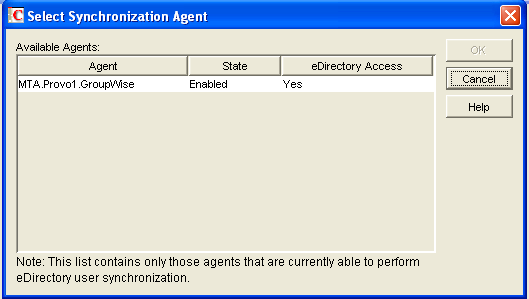
-
Select the MTA you want to perform eDirectory user synchronization for the selected domain, then click.
The domain should now display in the column of the eDirectory User Synchronization Configuration dialog box.
-
Repeat Step 1 through Step 3 until all domains in your GroupWise system are enabled for eDirectory user synchronization.
-
Click to return to the main ConsoleOne window.
Scheduling eDirectory User Synchronization
After eDirectory user synchronization is enabled, you can perform eDirectory user synchronization at any time from the NetWare MTA server console. See Performing eDirectory User Synchronization. In addition, you must create one or more eDirectory user synchronization events to cause eDirectory user synchronization to be performed on a regular basis.
To schedule an eDirectory user synchronization event:
-
In ConsoleOne, browse to and right-click the MTA object, then click .
-
Click to display the Scheduled Events page.
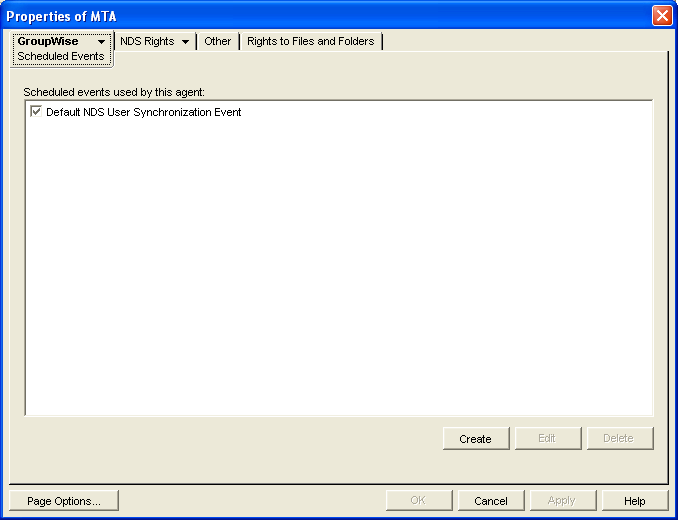
The Scheduled Events page lists a pool of MTA events available to all MTAs in your GroupWise system if any events have already been created.
-
Select an existing eDirectory user synchronization event, then click .
or
Click , then type a name for the event.
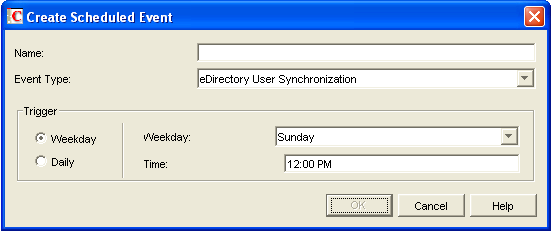
-
Set to .
-
In the box, specify when you want the eDirectory user synchronization event to take place.
You can have the synchronization event take place once a week, once a day, or at any other regular interval, at whatever time you choose.
-
Specify the time of day when you want eDirectory user synchronization to take place.
-
Click twice to close the scheduled event dialog boxes and save the eDirectory user synchronization event.
ConsoleOne then notifies the MTA to restart so the eDirectory user synchronization event can be put into effect.
41.4.2 Enabling MTA Message Logging
Message logging is turned off by default, because it causes the MTA to use additional CPU and disk resources. However, gathering information about message traffic on your GroupWise system lets you perform many valuable tasks, including:
-
Tracking messages
-
Gathering statistics to help optimize your GroupWise system
-
Billing customers for messages delivered
-
Tracking messages from the MTA Web console and from GroupWise Monitor
When you enable MTA message logging, the MTA stores data about GroupWise message traffic as it processes messages. The stored data is then available for use by the MTA Web console Message Tracking feature and by the GroupWise Monitor Message Tracking Report option. In addition, third-party programs can produce customized billing, tracking, and statistical reports based on the information stored in the database.
To enable MTA message logging:
-
In ConsoleOne, browse to and right-click the MTA object, then click .
-
Click .
-
In the field, select a logging level to turn message logging on.
-
In the field, specify the full path of the file where the MTA will record the logging information.
-
In the field, specify the number of days to retain reports on disk. Reports are automatically deleted after the specified time has passed.
NOTE:Other fields appearing on the Message Log Settings property page of the MTA object in ConsoleOne were valid in earlier versions of GroupWise, but are not supported by the GroupWise 7 MTA.
-
Click to save the MTA message log settings.
ConsoleOne then notifies the MTA to restart so the new settings can be put into effect.
Corresponding Startup Switches You can also use the /messagelogsettings, /messagelogpath, /messagelogdays, and /messagelogmaxsize switches in the MTA startup file to configure MTA message logging.
MTA Web Console For instructions on tracking messages after message logging is enabled, see Tracking Messages and Section 61.3.7, Message Tracking Report.